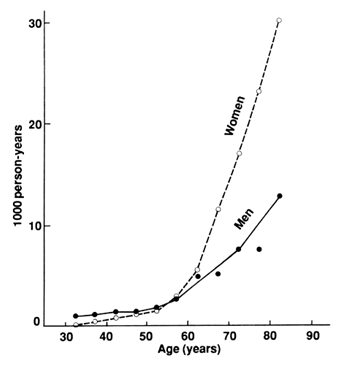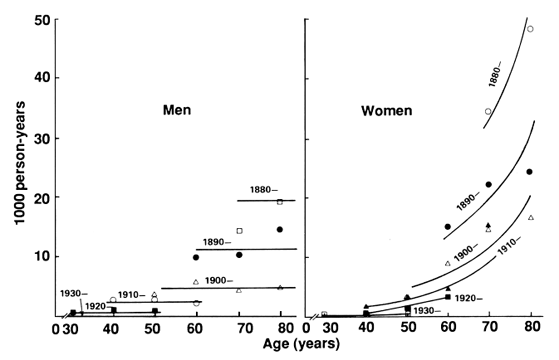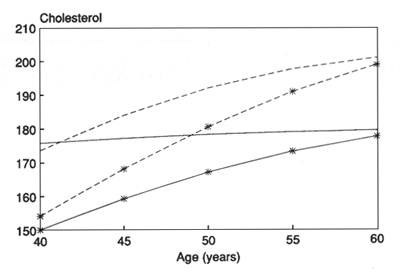Vast RERF Database Supplies Aging Clues
Cumulative data collected during three decades of biennial Adult Health Study examinations are an unparalleled resource for exploring the relationship between aging and various health factors, as well as for conducting various prospective studies on the aging process.
by F. Lennie Wong, Department of Statistics; and Kazunori Kodama and Hideo Sasaki, Department of Clinical Studies
This article was originally published in RERF Update 2(2):4,6, 1990.
As Japan and many other industrialized nations slowly evolve into geriatric societies, aging-related studies have been receiving more attention. In the past, RERF researchers have primarily been examining the possibility of radiation-induced acceleration of the aging process. But, in possessing a 30-year biennially updated database based on medical examinations conducted by the ABCC-RERF clinical staff, RERF is uniquely able to use this abundance of disease incidence, death, laboratory, and physiometric data to portray the lifetime pathological history of 20,000 AHS participants. No other institute in Japan has comparable data.
Utility of the AHS data in the study of nonlethal diseases
Temporal trends for cancers with short survival periods have been well delineated using death certificate information. However, for less lethal and/or curable cancers such as breast or thyroid and, more importantly, for certain noncancer diseases such as hypertension, diabetes mellitus, anemia, cataract, gastric ulcer, and hepatitis, neither temporal trends nor aging effects can be accurately depicted using the death certificate information, as these diseases appear infrequently as a cause of death. The AHS data can potentially provide the lacking incidence information for these diseases in aging-related studies. Certain diagnostic procedures employed in the AHS exams help to identify occult cases which contribute toward better disease ascertainment, making the overall program a more secure basis for the study of aging-related diseases.
Age and cohort effects on incidence data
Examination of the age-specific incidence rates in the AHS data readily reveals which diseases are associated with aging. The incidence of cardiovascular diseases, cataract, and osteoporosis increases steadily with age, whereas diseases such as duodenal ulcer and hyperthyroidism occur roughly uniformly across different age groups, thus lacking a monotonic relationship with chronological age. When considering these data, however, it is important to differentiate between age and cohort effects.
An impression of an overall increasing trend in disease incidence with age could arise as an artifact of a difference in cohort response due to a change in environmental condition. When appropriately stratified by birth cohort and other factors, the trend may remain or completely disappear. The typical example is vertebral fracture, which appears to increase with age (Figure 1). However, when incidence is shown by 10-year birth cohorts, a different view emerges. It is immediately recognized that the incidence differs significantly between birth cohorts even at the same age, and there is no increase in the incidence over the follow-up period, particularly in men (Figure 2). Hence, while a misleading picture may result if the cohort is not considered, it is the availability of the different cohorts in the 30-year AHS follow-up that actually enables us to examine the variation in incidence pattern among cohorts over time. This is useful knowledge not only to examine the possibility of radiation-induced acceleration of the aging process but also to incorporate into guidelines for current and future health management of the elderly afflicted with certain disorders.

Figure 1. The incidence of thoracic vertebral compression fractures in the AHS cohort (1958-1986) when birth cohort is not considered.

Figure 2. The incidence of thoracic vertebral compression fractures in the AHS cohort (1958-1986), shown by birth cohort.
Physiometric determinants and aging
The lifetime pattern of change in certain physiometric variables such as total serum cholesterol, blood pressure, and heart rate can also be examined using AHS data, thus providing another unique view of the aging process.
Although cross-sectional data may be used to assess age-related changes, an association with age may arise as a result of differences between groups rather than as a result of changing patterns for individuals. Thus, as in the case of disease incidence, age and cohort effects may be confounded, which can be avoided by instead using serial measurement data from the same individuals and by using appropriate statistical analysis such as the “growth curve” technique.
Figure 3 shows the difference in the fitted relationship between total serum cholesterol level and age for men and women using the cross-sectional data collected during 1984-1986 and that based on following the patterns of change for individuals beginning in 1958 for those who were 20 years old at the time of the bombing (ATB). While age effect could not be detected in the men from the cross-sectional analysis, there is an obvious age effect based on the follow-up of individuals. Disparate values of age-specific total serum cholesterol levels are indicated as well. Cross-sectional analysis, hence, may provide an incorrect impression of the underlying relationship, and the use of serial data is preferable for characterizing the patterns of individual response and change over time. AHS serial measurement data are available for participants of different birth cohorts (ranging in age from 0 to 70 years ATB), from whom data has been collected at ages ranging from 13 to 98 years. Hence, it is possible to broadly describe changing patterns that may be related to aging.

Figure 3. Fitted serum cholesterol level by age in men (solid lines) and women (dashed lines) based on cross-sectional analysis of data from 1984-1986 and on growth curve analysis of individuals who were 20 years old at the time of the bombings, assuming a constant body mass index of 0.002 (lines marked by asterisks.)
Our preliminary analyses using the growth curve technique have so far been able to depict lifetime patterns for total serum cholesterol, for diastolic and systolic blood pressures in relation to age, and additionally the influence of sex, city, birth cohort, and radiation exposure on these lifetime patterns. Efforts are underway to examine such relationships for other physiometric determinants.
Disease incidence and physiometric data
Long-term AHS follow-up data enables detection of incident cases for various diseases, and in the study of diseases related to the aging process, serial data on certain physiometric variables can be incorporated as possible risk factors. Other useful information is collected from the AHS subjects including alcohol consumption, dietary habits, tobacco use, parity, and occupation, all of which may be combined in designing studies to identify risk factors for certain diseases in relation to aging.
Opportunities for prospective aging research
Researchers in the Department of Clinical Studies are now conducting separate studies on aging-related diseases, such as cardiovascular disease and osteoporosis, with support from staff members of the departments of Statistics and Epidemiology. Prospective studies on aging-related conditions, such as senile dementia and cataract, are being planned, because the AHS participants have reached an average age of 61.2 years, thus providing unique opportunities for conducting such studies.

